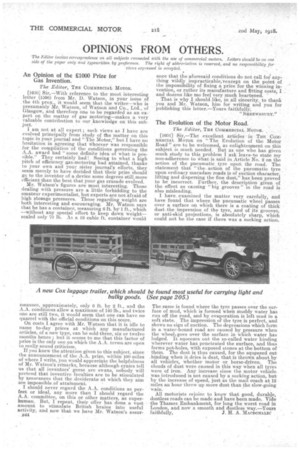-OPINIONS FROM OTHERS. -The Editor invites correspondence on all subjects
Page 20

If you've noticed an error in this article please click here to report it so we can fix it.
connected with the liSe of commercial motors. Letters should be on one side of the raper only and typewritten by preference. The right of abbreviation is reserved, and no responsibility for
views expressed is accepted.
An Opinion of the £1000 Prize for Gas Invention.
The Editor, THE COMMERCIAL MOTOR.
[1600] Sir,—'With reference to the most interesting letter (1096) from Mr. D. Watson, in your issue of the 4th prox., it would seem that the writer—who is presumably Mr. Watson, of Watson and Co., Ltd., of (41asgow, and therefore one to be regarded as an expert on the matter of gas motoring—makes a very valuable contribution to our knowledge on this subject. I am not at all expert ; such views as I have are evolved principally from study of the matter on this topic in your journal and "-The Motor," but I have no hesitation in agreeing that Whoever was responsible for the compilation of the conditions governing the A.A. award had "some definite idea of what is pessible." They certainly had! Seeing to what a high pitch of efficiency gas-motoring had attained, thanks to your own and your sister journal's efforts, they seem merely to have decided that their prize should go to the inventor of a device some degrees still,more efficient than the best that your gas crusade evolved. Mr. Watson's figures are most interesting. Those dealing with pressure are a little forbidding to the amateur experimentalist, hut experts are not afraid of high stovage pressures. Those regarding weight are both interesting and encouraging. Mr. Watson says that he has a container, measuring 6 ft. by-1 ft., which —without any special effort to keep down weight— scaled only 70 lb. As a 19 cubic ft. container would measure, approximately, only 6 ft. by 2 ft.., and the A.A. conditions allow a maximum of 140 lb., and twice one are still two, it would seem that one can have no quarrel with the official conditions on this score.
On costs I. agree with Mr. Watson that it is idle to name to-day prices at which any manufactured articles, of a new type, can be sold-three, six or twelve months hence ; but it seems to me that this factor of price is the only one on whieh the A.A. terms are open to really.sound criticism.
If you knew the attention given to this subject, since the announcement of the A.A. prize, within 100 miles of where I write, you would appreciate the helpfulness of MT. Watson's _remarks, because although cynics tell us that all inventors' geese are swans, nobody will pretend that inventive faculties are to be stimulated by assurances that the desiderata, at which they aim are impossible of attainment.
I should never regard the A.A. conditions as perfect or ideal, any more than I should regard the A.A. committee, on this or other Matters, as superhuman. But., I repeat, their offer has done a vast amount to stimulate British brains into useful activity, and now that we have Mr. Watson's assur. B44
ance that the aforesaid conditions do not call for' anything wildly impracticable,"lexcept on the point of the impossibility of fixing a price for the winning invention, or rather its manufacture and fitting costs, I and dozens like me feel very much heartened.
That is why I should like, in all sincerity, to thank you and Mr. Watson, him for writing and you for publishing this letter.—Yours faithfully,
"SHREWSBURY."
The Evolution of the Motor Road.
The Editor, THE COMMERCIAL MOTOR.
{1601] Sir,—The excellent articles in THE COMMERCIAL MOTOR on "The Evolution of the Motor Road 7 are to be welcomed, as enlightenment on this subject is much needed. But as one who has given much study to this problem I ask 'leave-to state my non-adherence to. What is said ia Article No. 2 on the action of the pneumatic tyre upoá the road. The statement that "the-action of the pneumatic tyre upon ordinary macadam roads is of suction character., lifting and dispersing the fine dust," has been proved to be incorrect. Further, the description given of the effect as causing "big grooves" in the road is also misleading.
I have examined the matter very carefully, and have found that wherethe pneumatic wheel passes over a. surface on which there is a coating of thick dust-the-impression of the tyre, and of its grooves, or anti-skid projections, is abeolutely sharp, which could net bethe case if there was a sucking action.
The same is found where the tyre passes over the surface of mid, which is formed when muddy water has run off the road, and by evaporation is left mud in a soft state. The impression of the tyre is perfect, and shows no sign of suction. The depressions which form in a wateis-bound road are caused by pressure when the wheels goes over the surface in which water has lodged. It squeezes out the so-called water binding wherever water has penetrated the surface, and thus forms pot-holes, with exposed stones at the bottom of them. The dust is thus caused, for the squeezed out _binding when it dries is dust, that is thrown about by all vehicles, whether motor or horse-driven. The clouds of dust were caused in this way when all tyres were of iron. Any increase since the motor vehicle was introduced is not caused by a sucking action, but by the increase of speed, just as the mail coach at 12 miles an hour throw up more dust than the slow-going wain.
All motorists rejoice to know that good, durable, dustless roads can be made and have been made. Vide the Thames Embankment, for long the worst road in London, and now a smooth and dustless way.—Yours
faithfully, J. H. A. MACDONALD!






















